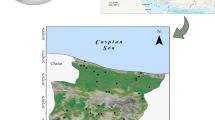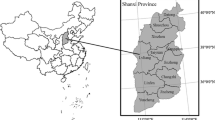Abstract
This study estimates fire risk in Swaziland using geographic information system (GIS) and remote sensing data. Fire locations were identified in the study area from remotely sensed Moderate Resolution Imaging Spectroradiometer (MODIS) active fire and burned area data for the period between April 2000 to December 2008 and January 2001 and December 2008, respectively. A total of thirteen biophysical and socio-economic explanatory variables were analyzed and processed using a Bayesian network (BN) and GIS to generate the fire risk maps. The interdependence of each of the factors was probabilistically determined using the expectation-maximization (EM) learning algorithm. The final probabilistic outputs were then used to classify the country into five fire risk zones for mitigation and management. Accuracy assessments and comparison of the fire risk maps indicate that the risk maps derived from the active fire and burned area data were 93.14 and 96.64% accurate, respectively, demonstrating sufficient agreement between the risk maps and the existing data. High fire risk areas are observed in the Highveld particularly plantation forests and grasslands and within the Lowveld sugarcane plantations. Land tenure and land cover are the dominant determinants of fire risk, the implications of which are discussed for fire management in Swaziland. Limitations of the data used and the modeling approach are also discussed including suggestions for improvements and future research.






Similar content being viewed by others
References
Adlassnig, K., & Scheithauer, W. (1989). Performance evaluation of medical expert systems using ROC curves. Computers and Biomedical Research, 22(4), 297–313.
Alonso-Betanzos, A., Fontenla-Romero, O., Guijarro-Berdiñas, B., Hernández-Pereira, E., Canda, E. Jimenez, J., Luis Legido, J., Muñiz, S., Paz-Andrade, C., & Paz-Andrade, M. I. (2002). A neural network approach for forest fire risk estimation. In: F. van Harmelen, (Ed.), Proceedings of the 15th European Conference on Artificial Intelligence. ECAI’2002, Lyon, France, pp. 643–647.
Archibald, S., Roy, D. P., Van Wilgen, B. W., & Scholes, R. J. (2009). What limits fire?: An examination of drivers of burnt area in sub-equatorial Africa. Global Change Biology, 15(3), 613–630. doi:10.1111/j.1365-2486.2008.01754.x.
Bachmann, A., & Allgower, B. (2001). A consistent wildland fire risk terminology is needed. Fire Management Today, 61(4), 28–33.
Chuvieco, E., & Kasischke, E. S. (2007). Remote sensing information for fire management and fire effects assessment. Journal of Geophysical Research, 112 (G01S90). doi:10.1029/2006JG000230.
Chuvieco, E., & Salas, J. (1996). Mapping the spatial distribution of forest fire danger using GIS. International Journal of Geographic Information Systems, 10(3), 333–345. doi:10.1080/02693799608902082.
Congalton, R. G., & Green, K. (2009). Assessing the accuracy of remotely sensed data: Principles and practices (2nd ed.). Boca Raton: Lewis Publishers.
Daniel, B. K., Zapata-Rivera, J.-D., & McCalla, G. I. (2007). A Bayesian belief network approach for modeling complex domains. In A. A Mittal, A. Kassim, & T. Tan (Eds.), Bayesian network technologies: Applications and graphical models (pp. 13–51). Hershey: IGI Publishing.
Dempster, A., Laird, N., & Rubin, D. (1977). Maximum likelihood from incomplete data via the EM algorithm. Journal of the Royal Statistical Society, B39(1), 1–38.
Dlamini, W. M. (2005). Fire situation in Swaziland. Proceedings of the 5th Southern Africa Fire Network (SAFNet) workshop: Towards Meeting Fire Management Challenges in Southern Africa, Mangochi, Malawi, pp. 24–26.
Dlamini, W. M. (2007). A review of the July 2007 Swaziland fire disaster using GIS and MODIS data. PositionIT, September/October 2007, 61–65.
Dlamini, W. M. (2009). Characterization of the July 2007 Swaziland fire disaster using satellite remote sensing and GIS. Applied Geography, 29(3), 299–307. doi:10.1016/j.apgeog.2008.10.007.
Dlamini, W. M. (2010). A Bayesian belief network analysis of factors influencing wildfire occurrence in Swaziland. Environmental Modelling & Software, 25(2), 199–208. doi:10.1016/j.envsoft.2009.08.002.
ESRI. (2008). ArcGIS: Release 9.3. Redlands, California: Environmental Systems Research Institute.
Giglio, L., Csiszar, I., & Justice, C. O. (2006). Global distribution and seasonality of active fires as observed with the Terra and Aqua MODIS sensors. Journal of Geophysical Research, 111(G02016), doi:10.1029/2005JG000142.
Giglio, L., Descloitres, J., Justice, C. O., & Kaufman, Y. (2003). An enhanced contextual fire detection algorithm for MODIS. Remote Sensing of Environment, 87(2–3), 273–282.
Giglio, L., Loboda, T., Roy, D. P., Quayle, B., & Justice, C. O. (2009). An active-fire based burned area mapping algorithm for the MODIS sensor. Remote Sensing of Environment, 113(2), 408–420.
Goudie, A. S., & Price-Williams, D. (1983). The atlas of Swaziland. Lobamba: The Swaziland National Trust Commission Occasional Paper No. 4. Swaziland National Trust Commission.
Grêt-Regamey, A., & Straub, D. (2006). Spatially explicit avalanche risk assessment linking Bayesian networks to a GIS. Natural Hazards and Earth System Sciences, 6(6), 911–926.
Hardy, C. C. (2005). Wildland fire hazard and risk: Problems, definitions, and context. Forest Ecology and Management, 211(1–2), 73–82.
Henriksen, H. J., Rasmussen, P., Brandt, G., Bülow, Dv., & Jensen, F. V. (2007). Public participation modelling using Bayesian networks in management of groundwater contamination. Environmental Modelling and Software, 22(8), 1101–1113.
Hernandez-Leal, P. A., Arbelo, M., & Gonzalez-Calvo, A. (2006). Fire risk assessment using satellite data. Advances in Space Research, 37(4), 741–746. doi:10.1016/j.asr.2004.12.053.
Iliadis, L. S. (2005). A decision support system applying an integrated fuzzy model for long-term forest fire risk estimation. Environmental Modelling & Software, 20(5), 613–621.
Jarvis, A., Reuter, H. I., Nelson, A., & Guevara, E. (2008). Hole-filled SRTM for the globe Version 4, available from the CGIAR-CSI SRTM 90 m Database, http://srtm.csi.cgiar.org. Accessed 28 March 2009.
Jensen, F. V. (2001). Bayesian networks and decision graphs. New York: Springer.
Justice, C. O., Giglio, L., Korontzi, S., Owens, J., Morisette, J. T., Roy, D., et al. (2002). The MODIS fire products. Remote Sensing of the Environment, 83(1–2), 244–262.
Kaloudis, S., Tocatlidou, A., Lorentzos, N. A., Sideridis, A. B., & Karteris, M. (2005). Assessing wildfire destruction danger: A decision support system incorporating uncertainty. Ecological Modelling, 181(1), 25–38.
Korb, K., & Nicholson, A. E. (2004). Bayesian artificial intelligence. London: Chapman & Hall.
Kraak, M., & Ormeling, F. (1996). Cartography, visualization of spatial data. Essex: Addison Wesley Longman Limited.
Lauritzen, S. L. (1995). The EM algorithm for graphical association models with missing data. Computational Statistics and Data Analysis, 19(2), 191–201.
Loboda, T., O’Neal, K. J., & Csiszar, I. (2007). Regionally adaptable dNBR-based algorithm for burned area mapping from MODIS data. Remote Sensing of Environment, 109(4), 429–442.
Lozano, F. J., Suárez-Seoane, S., Kelly, M., & Luis, E. (2008). A multi-scale approach for modeling fire occurrence probability using satellite data and classification trees: A case study in a mountainous Mediterranean region. Remote Sensing of Environment, 112(3), 708–719.
Manel, S., Williams, H. C., & Ormerod, S. J. (2001). Evaluating presence–absence models in ecology: the need to account for prevalence. Journal of Applied Ecology, 38(5), 921–931.
Marcot, B. G., Steventon, J. D., Sutherland, G. D., & McCann, R. K. (2006). Guidelines for developing and updating Bayesian belief networks applied to ecological modeling and conservation. Canadian Journal of Forestry Research, 36(12), 3063–3074.
Martínez, J., Vega-Garcia, C., & Chuvieco, E. (2009). Human-caused wildfire risk rating for prevention planning in Spain. Journal of Environmental Management, 90(2), 1241–1252. doi:10.1016/j.jenvman.2008.07.005.
Matondo, J. I., Peter, G., & Msibi, K. M. (2004). Evaluation of the impact of climate change on hydrology and water resources in Swaziland: Part II. Physics and Chemistry of the Earth, 29(15–18), 1193–1202.
McCann, R. K., Marcot, B. G., & Ellis, R. (2006). Bayesian belief networks: applications in ecology and natural resource management. Canadian Journal of Forestry Research, 36(12), 3053–3062.
Melching, C. S. (1995). Reliability estimation. In V. P. Singh (Ed.), Computer models of watershed hydrology (pp. 69–118). Highlands Ranch, Colorado: Water Resources Publication.
Metz, C. E. (1978). Basic principles of ROC analysis. Seminars in Nuclear Medicine, 8(4), 283–298.
Neapolitan, R. (2003). Learning Bayesian networks. Upper Saddle River: Prentice Hall.
Norsys Software Corporation. (2008). Netica version 4.10. http://www.norsys.com. Accessed 23 April 2009.
Pearl, J. (1988). Probabilistic reasoning in intelligent systems: Networks of plausible inference. San Mateo: Kaufmann.
Pollino, C. A., Woodberry, O., Nicholson, A., Korb, K., & Hart, B. T. (2007). Parameterisation and evaluation of a Bayesian belief network for use in an ecological risk assessment. Environmental Modelling & Software, 22(8), 1140–1152.
Preisler, H. K., Brillinger, D. R., Burgan, R. E., & Benoit, J. W. (2004). Probability based models for estimation of wildfire risk. International Journal of Wildland Fire, 13(2), 133–142.
Pyne, S. J., Goldammer, J., de Ronde, C., Geldenhuys, C. J., Bond, W. J., & Trollope, S. W. (2004). Introduction. In J. G. Goldammer & C. de Ronde (Eds.), Wildland fire management handbook for Sub-Sahara Africa (pp. 1–10). Freiburg: Global Fire Monitoring Centre (GFMC).
Qu, J. J., Wand, W., Dasgupta, S., & Hao, X. (2008). Active fire monitoring and fire danger potential detection from space: A review. Frontiers of Earth Science in China, 2(4), 479–486. doi:10.1007/s11707-008-0044-7.
Remmelzvaal, A. (1993). Physiographic Map of Swaziland, Scale 1:250,000. FAO/UNDP/GOS Land Use Planning for Rational Utilization of Land and Water Resources Project SWA/89/001. Field Doc. 41, Mbabane.
Roques, K. G., O’Connor, T. G., & Watkinson, A. R. (2001). Dynamics of shrub encroachment in an African savanna: Relative influences of fire, herbivory, rainfall and density dependence. Journal of Applied Ecology, 38(2), 268–280.
Roy, D. P., Boschetti, L., Justice, C. O., & Jua, J. (2008). The collection 5 MODIS burned area product—Global evaluation by comparison with the MODIS active fire product. Remote Sensing of Environment, 112(9), 3690–3707.
Roy, D. P., Jin, Y., Lewis, P. E., & Justice, C. O. (2005). Prototyping a global algorithm for systematic fire-affected area mapping using MODIS time series data. Remote Sensing of Environment, 97(2), 137–162.
Smith, R., Goodman, P., & Matthews, W. (2006). Systematic conservation planning: A review of perceived limitations and an illustration of the benefits, using a case study from Maputaland, South Africa. Oryx, 40(4), 400–410.
Spiegelhalter, D. J., Dawid, A. D., Lauritzen, S. L., & Cowell, R. G. (1993). Bayesian analysis in expert systems. Statistical Science, 8(3), 219–283.
Sweet, R. J., & Khumalo, S. (1994). Range resources and grazing potentials in Swaziland. Mbabane: Ministry of Agriculture and Cooperatives/United Nations Development Programme.
Taroni, F., Biedermann, A., Gabolino, P., & Aitken, C. G. G. (2004). A general approach to Bayesian belief networks for the interpretation of evidence. Forensic Science International, 139(1), 5–16.
Uusitalo, L. (2007). Advantages and challenges of Bayesian networks in environmental modeling. Ecological Modelling, 203(3–4), 312–318.
Van Wilgen, B. W., & Scholes, R. J. (1997). The vegetation and fire regimes of Southern hemisphere Africa. In B. W. van Wilgen, M. O. Andreae, J. G. Goldammer, & J. A. Lindesay (Eds.), Fire in southern African Savannas: Ecological and atmospheric perspectives (pp. 27–43). Johannesburg: Witwatersrand University Press.
Vasilakos, C., Kalabokidis, K., Hatzopoulos, J., Kallos, G., & Matsinos, Y. (2007). Integrating new methods and tools in fire danger rating. International Journal of Wildland Fire, 16(3), 306–316.
Acknowledgments
The complementary license for the Netica software was provided by Norsys Software Corporation with the help of Brent Boerlage and Jennie Yendall. The active fire and burned area data are distributed by the Land Processes Distributed Active Archive Center (LP DAAC), located at the US Geological Survey (USGS) Earth Resources Observation and Science (EROS) Center (lpdaac.usgs.gov).
Author information
Authors and Affiliations
Corresponding author
Rights and permissions
About this article
Cite this article
Dlamini, W.M. Application of Bayesian networks for fire risk mapping using GIS and remote sensing data. GeoJournal 76, 283–296 (2011). https://doi.org/10.1007/s10708-010-9362-x
Published:
Issue Date:
DOI: https://doi.org/10.1007/s10708-010-9362-x




